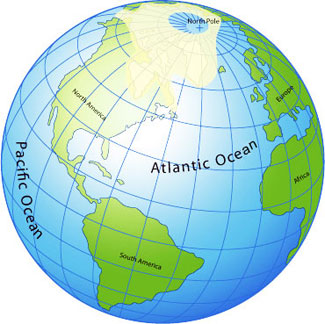How do Polar Bears stay warm?
The polar bear loves and is well adapted to the cold and icy climate of the Arctic. They have a dense fur that has hollow air-filled hairs which insulate the polar bear from the frigid weather conditions. The fur also allows them to absorb the sunlight which also keeps them warm. They also have a layer of blubber or fat that also adds protection, this layer can sometimes be 4 to 5 inches thick.
Why is the Polar Bear's fur white?
Actually it is not white, because each hair is a hollow tube; it is free of any pigments and is transparent. Polar bears look white because of the way the light hits the hollow hair and reflects the visible light, especially in the sunlight.
How do Polar Bears swim?
Their very large paws are partially-webbed, which helps them be excellent swimmers, they have been known to swim 100 miles at one stretch.
How do Polar Bears keep from slipping on the ice?
The paw pads have a rough surface which helps the polar bear from slipping on the ice.
Do Polar Bears hibernate like other bears?
No they do not, they spend most of their lives on the sea ice, and when a female polar bear is going to have baby bears, she will make dens in the earth or snow. They primarily build the dens on land, but once in a while they may build a den in the snow on a floating ice cap. The mother polar bear will stay with her cubs in the den where it is safe until spring.
Where do Polar Bears live?
They live in the arctic north, which is all directions that surround the North Pole; this includes US (Alaska), Canada, Russia, Denmark (Greenland). To learn more about where polar bears live, take a moment to visit the Polar Bears International website.
What does the loss of sea ice have to do with the Polar Bear?
The polar bears live and hunt on sea ice. This is where they spend most of their time, the larger the gap of water is from land to the floating sea ice, makes it harder for the polar bears to reach the ice caps. The are excellent swimmers, but the distance between the land and the ice caps may prove too big for the polar bear to swim much more dangerous.
Are the Polar Bears on the Endangered Species List?
Yes, on May 14, 2008, the US Department of the Interior changed the classification of the polar bear from threatened to endangered. The major reason for this was the concerns about the loss of sea ice in the polar bears habitat.
How much do Polar Bears weigh?
An average adult male may weigh from 720 to 1,700 pounds. Females are not so big and weigh around 500 to 600 pounds.
How many baby bears do Polar Bears have?
A Polar Bear baby is called a cub. A female polar bear can give birth to one to three cubs, but will normally give birth to 2 cubs. She will give birth sometime in the month of January in the den she built to keep them safe where they can grow big and strong until spring, which is when they will first venture out into the Arctic wilderness. The cubs will stay with their mothers for about 20 months. In that time, she will teach them to hunt and learn how to live in the cold Arctic environment. For those cubs born in the high Arctic, where life is a little more challenging, the cubs will stay with their mother for another year.
How big are Polar Bear cubs when they are born?
The newborn cubs are only about 12 to 14 inches long and weigh just about one pound.
What is the scientific name for Polar Bear?
The scientific name for polar bear is Ursus Maritimus, which means "sea bear."
Sources:
Polar Bear International: http://www.polarbearsinternational.org/bear-facts/polar-bear-fur/ National Wildlife Federation: http://www.nwf.org/polarbear/ National Geographic: http://kids.nationalgeographic.com/Animals/CreatureFeature/Polar-bear
